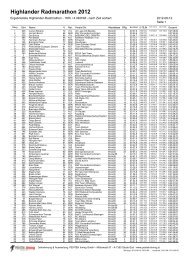Großbritannien-Exkursion - oppelshausen
Großbritannien-Exkursion - oppelshausen
Großbritannien-Exkursion - oppelshausen
Sie wollen auch ein ePaper? Erhöhen Sie die Reichweite Ihrer Titel.
YUMPU macht aus Druck-PDFs automatisch weboptimierte ePaper, die Google liebt.
Millennium Bridge<br />
The Millennium Bridge is London’s first<br />
new river crossing in more than a century.<br />
The 350 metres-long pedestrian bridge links<br />
the City and St. Paul’s Cathedral, on the<br />
north bank of the Thames, with Tate<br />
Modern, the new gallery of modern art on<br />
the south bank. The very shallow suspension<br />
bridge has been developed in close<br />
collaboration with sculptor Sir Anthony<br />
Caro and engineers Ove Arup & Partners.<br />
Formed by a single sweeping arc, it appears<br />
as a thin ribbon of steel. Eight cables, four<br />
on either side of the deck, dip just 2.3 metres<br />
over the 144 metres central span. The cables<br />
are anchored at each end in concrete<br />
abutments and supported at two points in the<br />
river by concrete elliptical piers. Steel<br />
transverse arms support the light-weight<br />
deck by clamping onto the cables at 8 metres<br />
intervals. This structure is exposed on the<br />
underside where it forms a delicate lattice<br />
across the soffit.<br />
“The bridge opened to the public on 10 June<br />
2000 when an estimated 80,000 to 100,000<br />
people crossed it. As with all bridge<br />
structures, the Millennium Bridge is subject<br />
to a degree of movement. However, when<br />
large groups of people were crossing,<br />
greater than expected sideways movements<br />
Pedestrian Bridge at West India Dock<br />
Architekten: Future Systems<br />
Tragwerksplanung: Anthony Hunt Associates<br />
- 26 -<br />
occurred. The maximum sway of the deck<br />
was approximately 70mm. In order to fully<br />
investigate and resolve this phenomenon the<br />
decision was taken to close the bridge on 12<br />
June. [...] A programme of research was<br />
undertaken during the summer of 2000. A<br />
solution was then developed using the<br />
results of these tests. Arup has warned other<br />
bridge designers of their findings and the<br />
British Standard code of bridge loading is<br />
being updated to cover the phenomenon,<br />
now becoming referred to as Synchronous<br />
Lateral Excitation.<br />
The research indicated that the movement<br />
was caused by the sideways loads we<br />
generate when walking. Chance correlation<br />
of our footsteps when we walk in a crowd<br />
generated slight sideways movements of the<br />
bridge. It then became more comfortable for<br />
people to walk in synchronization with the<br />
bridge movement.<br />
This instinctive behavior ensures that the<br />
sideways forces we exert match the resonant<br />
frequency of the bridge, and are timed such<br />
as to increase the motion of the bridge. As<br />
the magnitude of the motion increases, the<br />
total sideways force increases and we<br />
becomes more correlated.” -<br />
http://www.arup.com/




